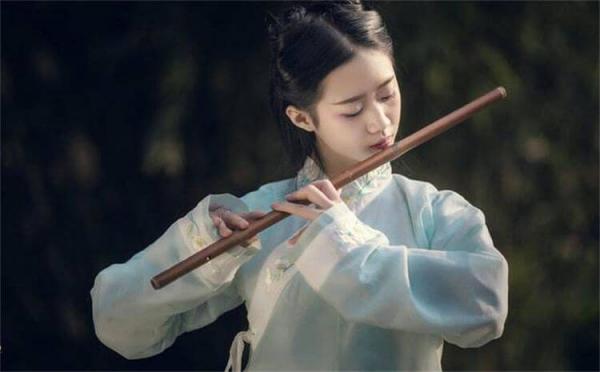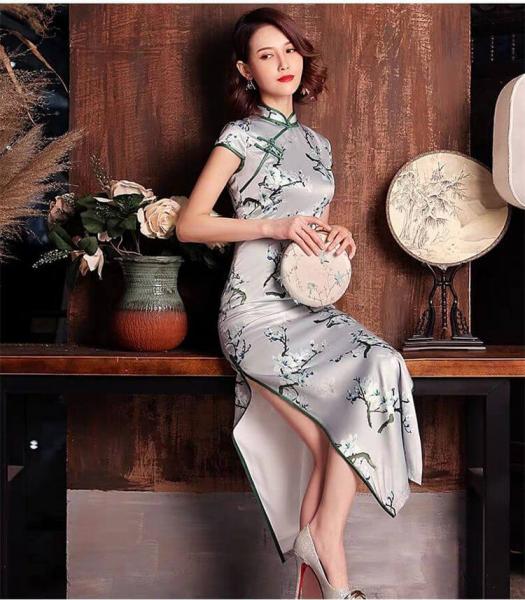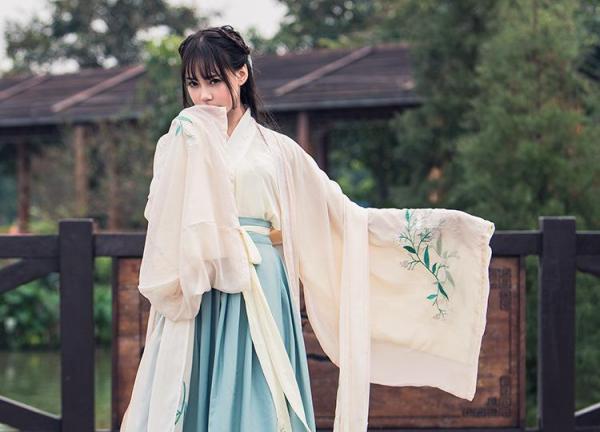Traditional Chinese Clothing Style: Hanfu, Qipao, and Beyond
Chinese Traditional Clothing: A Reflection of Cultural Heritage
Traditional Chinese clothing, also known as Hanfu (汉服), holds a special place in Chinese history and culture. Hanfu refers to the traditional attire worn by the Han Chinese people, the largest ethnic group in China. It is characterized by loose-fitting robes with flowing sleeves and distinctive collar styles. The term "Hanfu" itself translates to "clothes of the Han people." Hanfu reflects the essence of traditional Chinese aesthetics, showcasing elegance, modesty, and harmony.
Hanfu

Hanfu is a traditional Chinese attire that has been around for thousands of years, and it has undergone a lot of changes over time. The clothes is typically made from high-quality fabrics, and its designs vary depending on the wearer's gender, social status, and the era in which they were worn. There are hanfu from Han Dynasty, Tang Dynasty, Song Dynasty, and Ming Dynasty, each with distinguished design, pattern, and style.
For women, Hanfu usually consists of a long, loose-fitting robe called a Qun (裙) or a Ruqun (襦裙). The Qun is a wrap-around skirt, while the Ruqun is a two-piece ensemble with a blouse-like top and a long skirt. These garments are typically adorned with beautiful embroideries, intricate patterns, and colorful accessories, reflecting the artistic and aesthetic sensibilities of ancient China.On the other hand, men's Hanfu typically comprises a robe called a Zhishen (直身) or a Shenyi (深衣). The Zhishen is a loose-fitting robe with long sleeves, while the Shenyi is a cross-collared robe that symbolizes higher social status. Men's Hanfu often features a wide belt known as a Datong (大通) to secure the robe at the waist.
Hanfu has been an integral part of Chinese culture for centuries, and it continues to play a significant role in modern-day China. In fact, the popularity of Hanfu has been on the rise in recent years, with more and more people embracing this traditional attire. Hanfu enthusiasts often participate in events where they can showcase their elaborate Hanfu outfits and learn more about the history and culture of this ancient Chinese attire. As such, Hanfu is not just a piece of clothes but a symbol of Chinese tradition, culture, and identity.
Qipao: The Iconic Chinese Dress

In addition to its popularity in China, the Qipao has also gained a following in other parts of the world. In fact, many fashion designers have incorporated elements of the Qipao into their collections, creating modern interpretations of the classic dress. The Qipao has also been the subject of academic study, with scholars examining its cultural significance and impact on fashion.
Furthermore, the traditional chinese clothing of Qipao has inspired many works of art, including paintings, photographs, and sculptures. It has also been featured in literature, with authors describing its beauty and elegance in their works. Overall, the Qipao is a garment that has transcended time and geography, representing the beauty and grace of Chinese culture to people around the world.
>> Recommended 4-day Shanghai Tour for Women to tailor make a Qipao
Beyond Hanfu and Qipao: Exploring Other Tradnal Chinese Clothing

Chinese Men’s Traditional Fashion
Traditional chinese clothing for male includes the magua, long shirt (Changshan), straight jacket (Zhiduo) and Zhongshan suit.
Traditional Chinese Clothing of the 56 Ethnic Groups in China
| Ethnic Group | Representative Costume | Primary Residence |
| Han | Hanfu, Changshan | Nationwide |
| Mongolian | Deel (Terlig) | Inner Mongolia, Liaoning |
| Tibetan | Chuba | Tibet, Qinghai |
| Uyghur | Atlas dress | Xinjiang |
| Miao | "Hundred Birds" robe | Guizhou, Hunan |
| Zhuang | Brocade jacket | Guangxi |
| Manchu | Qipao, Magua | Liaoning, Heilongjiang |
| Korean | Hanbok | Jilin |
| Yi | Charwa cape | Sichuan, Yunnan |
| Tujia | Xilankapu coat | Hunan, Hubei |
| Hui | Skullcap, Hijab | Ningxia, Gansu |
| Kazak | Chapan robe | Xinjiang |
| Dong | Cross-collar shirt | Guizhou |
| Yao | "Dog-tail" shirt | Guangxi |
| Bai | Tie-dyed vest | Yunnan |
| Hani | "Tortoiseshell" hat | Yunnan |
| Lisu | Hemp robe | Yunnan |
| Lahu | Short jacket | Yunnan |
| Wa | Collarless shirt | Yunnan |
| She | Phoenix costume | Fujian, Zhejiang |
| Gaoshan | Shell-beaded shirt | Taiwan |
| Naxi | Seven-star cape | Yunnan |
| Jingpo | Silver-bubble dress | Yunnan |
| Kyrgyz | White felt hat | Xinjiang |
| Tu | Color-sleeved jacket | Qinghai, Gansu |
| Daur | Roe deer robe | Inner Mongolia |
| Mulam | Cross-collar shirt | Guangxi |
| Qiang | Goatskin vest | Sichuan |
| Blang | Black jacket | Yunnan |
| Salar | White-top hat | Qinghai, Gansu |
| Maonan | Flower bamboo hat | Guangxi |
| Gelao | Barrel skirt | Guizhou |
| Xibe | Archery robe | Liaoning, Xinjiang |
| Achang | Silver robe | Yunnan |
| Pumi | Goatskin shawl | Yunnan |
| Tajik | Embroidered hat | Xinjiang |
| Nu | Hemp robe | Yunnan |
| Uzbek | Atlas shirt | Xinjiang |
| Russian | Sarafan dress | Inner Mongolia, Xinjiang |
| Evenki | Roe deer head hat | Inner Mongolia |
| De'ang | Rattan waist hoop | Yunnan |
| Bonan | White trumpet hat | Gansu |
| Yugur | "Head surface" headdress | Gansu |
| Jing (Vietnamese) | Áo dài | Guangxi |
| Tatar | Embroidered cap | Xinjiang |
| Oroqen | Roe deer coat | Heilongjiang |
| Hezhen | Fish skin suit | Heilongjiang |
| Monba | Pulu robe | Tibet |
| Lhoba | Bearskin hat | Tibet |
| Jino | "Sunflower" shirt | Yunnan |
Recommended China tours to meet ethnic minority people in their traditional clothes
Traditional Chinese Clothes Pairing Guide by Occasion
In today's daily life as well as on special occasions or festivals, Chinese people may still wear traditional costumes.
| Occasion | Typical Women's Attire | Typical Men's Attire |
| Traditional Chinese Wedding | Dragon-Phoenix Gown (Cantonese)/Xiuhuafu (Northern) | Changshan with Magua Jacket |
| Modern Wedding Banquet | Modified Qipao | Mandarin Collar Suit |
| Spring Festival | Tang Suit Dress | Knotted Button Tang Suit |
| Mid-Autumn Festival | Hanfu - Ruqun Skirt | Zhiduo Robe |
| Casual Wear | Ramie Cross-Collar Top + Mamian Skirt | Linen Buttonless Shirt + Wide-Leg Pants |
| Business Meeting | Stand-Collar Qipao Dress | Modified Zhongshan Suit |
| Music and Dance Show | Various traditional Chinese clothing from hanfu, Tang costumes, to qipao | Warrior Uniform |
Where to Buy Traditional Chinese Clothing
In Beijing
Hanshe Xiangjun Pavilion and Yunshang Ji, located at No. 97 and No. 100, Nanluoguxiang, offer a wide range of Hanfu, accessories and shoes for sale. Guofeng Pavilion · Beijing Qianmen Hanfu Experience Center, located at No. 69, Qianmen Street, offers Hanfu rental, photography and purchase services. Hanfu Shop, located at No. 97, Guizi Street, offers Hanfu rental and custom-made services.
Hall Cheongsams and Rui Fu Xiang are famous tailor-made qipao shops in Beijing.
In Xian
The ancient city walls and many historical buildings in Xi'an are excellent places to take photos of Hanfu. It is highly recommended you rent a hanfu and take photos on your Xian tour. Yizhou Mall, located in Zhonghuan Square 1, Beilin District, offers Hanfu rental services. In addition, there are many shops selling Hanfu.
>> Get a custom China tour itinerary to experience traditional Chinese culture when be dressed in Chinese traditional clothing
In Shanghai
Shanghai, where the Chinese qipao was most popular during the Republican era in the early 20th century, is the best place to get a customized cheongsam. On your Shanghai tour, Li Gu Long, Feng He Xiang, and other stores have masters who can customize a cheongsam dress according to your body shape and liking.
In Hangzhou
Hangzhou is one of the famous Chinese silk producing areas and silk processing cities. The excavation of silk fabrics from the Liangzhu archaeological site, 4,700 years ago, has revealed the long history of silk in Hangzhou. Huashang Jiuzhou is a hanfu brand founded in Hangzhou in 2018, specializing in hanfu, accessories and cultural promotion activities. The brand name “Huashang” symbolizes the traditional Chinese clothing.
Traditional Chinese clothing is a treasure trove of Chinese culture, history of China, and artistic expression, showcasing the elegance and aesthetics of ancient China. From the graceful Hanfu to the iconic Qipao, and the lesser-known Tangzhuang, Zhongshan Suit, Pienfu, Ruqun, Moxiong, and Magua, each garment carries its unique charm and significance. By preserving and celebrating traditional Chinese clothes, we can continue to appreciate the rich heritage that has shaped Chinese culture for centuries.